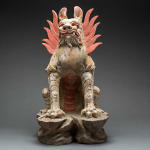Tang Sculpture of a Spirit Guardian, 618 CE - 906 CE
Terracotta
54 x 29 cm
21 1/4 x 11 3/8 in
21 1/4 x 11 3/8 in
LA.566
Further images
The inclusion of fantastic animal guardians as part of the retinue of tomb figures began in the Northern Wei dynasty (386-534) and continued into the Tang dynasty. Also called earth...
The inclusion of fantastic animal guardians as part of the retinue of tomb figures began in the Northern Wei dynasty (386-534) and continued into the Tang dynasty. Also called earth spirits (), or ‘zhenmushou’ ("tomb-guarding beasts"), these guardians took the form of a fantastic hybrid creature composed of various animal and sometimes human elements and were placed in the tomb in pairs to ward off any malevolent beings who threatened to intrude. Such idea was indeed already present during the Warring States period (5th-4th centuries BC) in tombs from the southern state of Chu, where often ‘zhenmushou’ with incredible antler tines and long tongues sticking out were placed at the entrance of the tomb to guard the coffin and protect it from evil.
However, in the south, tomb guardians quickly disappeared after the Eastern Jin period (317-420), an abrupt change of practice that probably reflected different cultural approaches. This was probably due to the fact that northern people -being more mindful of spirits and demons- were always more inclined to protect the dead from undesirable encounters and went into a lot of effort in creating wonderful sculptures of tomb guardians; southerners instead simply chose to continue to transmit the age-old practice of providing for the daily life of the deceased in the afterlife.
The painted animal guardian is here depicted with quite a ferocious feline head with fangs out and upturned ears, his red-painted mane on the side and the back made of protruding spikes stretching upwards, his powerful paws firmly placed on top of rocks. This type of ‘zhenmushou’ probably evolved from the dorsal-spiked beasts of the Han and Western Jin period (see X.0351) and was later refined during the Six Dynasties period. His menacing look would seem to indicate a northern workshop, during the early to mid Tang period.
Reference: J. Watt et al, China. Dawn of a Golden Age, 200-750 AD, New York, 2004: no. 178-179, pp. 286-287.
However, in the south, tomb guardians quickly disappeared after the Eastern Jin period (317-420), an abrupt change of practice that probably reflected different cultural approaches. This was probably due to the fact that northern people -being more mindful of spirits and demons- were always more inclined to protect the dead from undesirable encounters and went into a lot of effort in creating wonderful sculptures of tomb guardians; southerners instead simply chose to continue to transmit the age-old practice of providing for the daily life of the deceased in the afterlife.
The painted animal guardian is here depicted with quite a ferocious feline head with fangs out and upturned ears, his red-painted mane on the side and the back made of protruding spikes stretching upwards, his powerful paws firmly placed on top of rocks. This type of ‘zhenmushou’ probably evolved from the dorsal-spiked beasts of the Han and Western Jin period (see X.0351) and was later refined during the Six Dynasties period. His menacing look would seem to indicate a northern workshop, during the early to mid Tang period.
Reference: J. Watt et al, China. Dawn of a Golden Age, 200-750 AD, New York, 2004: no. 178-179, pp. 286-287.











